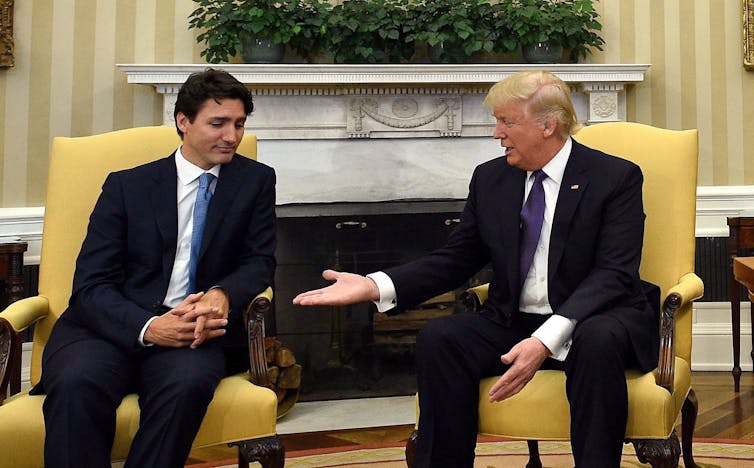��is an��Associate Professor in International Development Studies at��.
“,” wrote the��National Intelligencer and Washington Advertiser, an influential Washington newspaper, in February 1847.
The United States had just purchased 55 per cent of Mexico for US$15 million as part of the��. The pact concluded the bloody��, which claimed thousands of lives.
Despite the loss of life, and��, the treaty painted the whole experience as a rightful “cession” of land rather than a conquest.
Every Canadian needs to pay attention to this bit of American history. In one treaty, the U.S. annexed the present-day states of California, Nevada, Utah, New Mexico, Arizona, Colorado, Oklahoma, Kansas and Wyoming. It subsequently illegally invaded Indigenous territory in the west.
Canada could be next — perhaps not immediately as the 51st state, but quite possibly as a U.S. territory that would deny Canadians any voting rights for Congress or the presidency, allow only some autonomy and make questions of citizenship ambiguous. The constitutional architecture exists in the U.S. to make it happen.
New north strong and free?

How should Canada reimagine itself in the age of Trump?��We asked six �鶹��ý experts to answer that question — offering insights into how Canadians should navigate the choices ahead.��
Impossible? Unthinkable? Many pundits dismiss Trump’s bellicose rhetoric as hot-headed bargaining.��, they say. Some have argued his bluster is simply part of his favoured “” negotiating tactics.
That’s the wrong reading. . There is both potential and precedent for the U.S. to acquire territory through cession or subjugation.

Invading Canada
The of 1930 was also drummed up by the U.S. Department of War on how to invade Canada if ever needed.
It included shocking details about kicking off the attack in Halifax with poison gas, quickly invading New Brunswick and then occupying Québec City and Montréal before claiming Niagara Falls.
Historically, America has made many Canadian leaders nervous. Queen Victoria felt that Ottawa, as a capital, would be . John A. Macdonald worried about Union forces attacks on Canada, .
.
Treaties and congressional green lights
Hypothetical paranoia aside, the ability of the U.S. to acquire territories is ingrained in the U.S. Constitution. It is straightforward. First, :
“He [The President] shall have Power, by and with the Advice and Consent of the Senate to make Treaties, provided two thirds of the Senators present concur…”.
Treaties are the tools the U.S. uses to take “nothing by conquest” after the Senate ratifies those treaties by a two-thirds majority.
In 1848, President Zachary Taylor proposed the Treaty of Guadalupe Hidalgo to Congress to annex Mexican lands. Even though some wanted to take all of Mexico, Congress ratified the treaty.
In 1898, Congress passed . It ratified President William McKinley’s treaty of the annexation of Hawaii. Due to protest, petition and dissent, it took 60 years for Hawaii to become an official state in 1957.
The American origin story of a country born in revolution only applies to a small piece of the country. The rest of the place came to exist through annexation. The U.S. expanded to 50 states and 14 overseas territories through a mix of cession, occupation and purchase.
The role of dissent
From the — which saw 827,987 square miles pass from France to the United States — to the cession of the , , the belief that the expansion of the U.S. throughout the Americas was both justified and inevitable, is built into the spine of the U.S. Constitution.
But so, too, is dissent.
Once the U.S. legally acquires territories, of the constitution grants Congress the authority to manage them or dispose of them:
“The Congress shall have Power to dispose of and make all needful Rules and Regulations respecting Territory and other Property belonging to the United States.”
If a territory was unjustly acquired through a treaty, through unlawful means or if it challenges American interests, then it can be disposed of. The Marshall Islands is case in point.
After serving as a U.S. nuclear testing ground, the country ratified a constitution in 1979 and is now in .
, thinking it would be a good place for freed Black slaves to establish themselves to escape discrimination in southern States while protecting the Dominican Republic from invasion by Haiti. Congress had none of it, and failed to ratify the treaty.
Cuba’s exclusion — over sugar
In 1898, the , Puerto Rico, the Philippines and Guam. Within six months, Spain surrendered and treaties of annexation by cession were drawn for each territory. The U.S. gained sovereignty over all except Cuba, although the Philippines .
. He painted his ambitions in flowery rhetoric about the importance of autonomy, self-governance and the rights of man.
But in fact, Teller wanted to keep Cuba out to protect domestic sugar beet growers. The Senate passed the amendment excluding Cuba. Four years later, however, another amendment .
Opening lines of communication
It seems hard to fathom that discussions about U.S. annexation efforts against Canada are actually unfolding. Alarming indeed, but it would be a mistake to ignore history, overlook the U.S. Constitution and try to outwit the art of the deal.
Trump’s calls for Canada to join the U.S. could only happen by drafting a treaty demonstrating that a process of cession, purchase or occupation is legal. Only then could Congress approve it, and only with a two-thirds majority of the Senate. Trump does not have two-thirds of the Senate.
The correct move is to get Canadian voices to Congress. The strength of Canada–U.S. relations has always been through person-to-person relations in a deeply intertwined stew of familial and business relations.
Trump does not see the value in that. Congress, however, might, especially if annexing Canada proves expensive.
This is why Canadian politicians at federal, provincial and even municipal levels need to open lines of communication with Congress, especially in economically strategic states.
 ��
��
Ask an expert: Why would anyone want to be Liberal Party leader right now?
Now that Justin Trudeau has agreed to step down as Liberal leader, possible contenders to replace him must weigh their ambitions for the position against a still-bleak electoral outlook for the federal party. Dal’s Scott Pruysers explains how it could all play out.
Congressional representatives need to view annexing Canada as a ridiculous burden, both politically and financially, rather than as a prize.![]()
This article is republished from����under a Creative Commons license. Read the��.

